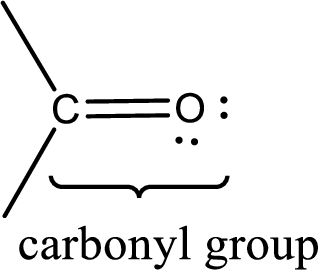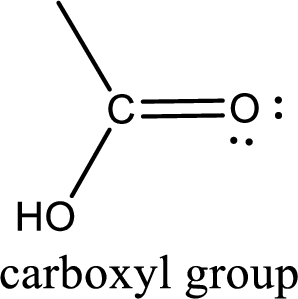
EBK GENERAL, ORGANIC, AND BIOLOGICAL CH
7th Edition
ISBN: 8220100853180
Author: STOKER
Publisher: CENGAGE L
expand_more
expand_more
format_list_bulleted
Concept explainers
Question
Chapter 16.1, Problem 1QQ
Interpretation Introduction
Interpretation:
Concept Introduction:
Carbonyl groups are the one which contain a double bond between carbon and oxygen atom.

If a hydroxyl group is attached to a carbonyl group means it is known as carboxyl group. This can be represented as shown below,

Expert Solution & Answer
Want to see the full answer?
Check out a sample textbook solution
Students have asked these similar questions
Write the amididation reaction mechanism of a-aminophenol and acetic acid to produce acetaminophen
For the condensation reaction between Alamine and histamine, please help me write the amididation reaction mechanism. Then write the three letter code for the product of the reaction, then write the one letter code for the product of the reaction. 
How to draw the reaction mechasnism below
Chapter 16 Solutions
EBK GENERAL, ORGANIC, AND BIOLOGICAL CH
Ch. 16.1 - Prob. 1QQCh. 16.1 - Prob. 2QQCh. 16.1 - Prob. 3QQCh. 16.1 - Prob. 4QQCh. 16.1 - Prob. 5QQCh. 16.2 - Prob. 1QQCh. 16.2 - Prob. 2QQCh. 16.2 - Prob. 3QQCh. 16.2 - Prob. 4QQCh. 16.2 - Prob. 5QQ
Ch. 16.3 - Prob. 1QQCh. 16.3 - Prob. 2QQCh. 16.3 - Prob. 3QQCh. 16.4 - Prob. 1QQCh. 16.4 - Prob. 2QQCh. 16.4 - Prob. 3QQCh. 16.5 - Prob. 1QQCh. 16.5 - Prob. 2QQCh. 16.5 - Prob. 3QQCh. 16.6 - Prob. 1QQCh. 16.6 - Prob. 2QQCh. 16.7 - Prob. 1QQCh. 16.7 - Prob. 2QQCh. 16.7 - Prob. 3QQCh. 16.8 - Prob. 1QQCh. 16.8 - Prob. 2QQCh. 16.8 - Prob. 3QQCh. 16.8 - Prob. 4QQCh. 16.9 - Prob. 1QQCh. 16.9 - Prob. 2QQCh. 16.10 - Prob. 1QQCh. 16.10 - Prob. 2QQCh. 16.11 - Prob. 1QQCh. 16.11 - Prob. 2QQCh. 16.11 - Prob. 3QQCh. 16.12 - Prob. 1QQCh. 16.12 - Prob. 2QQCh. 16.12 - Prob. 3QQCh. 16.12 - Prob. 4QQCh. 16.13 - Prob. 1QQCh. 16.13 - Prob. 2QQCh. 16.14 - Prob. 1QQCh. 16.14 - Prob. 2QQCh. 16.14 - Prob. 3QQCh. 16.15 - Prob. 1QQCh. 16.15 - Prob. 2QQCh. 16.15 - Prob. 3QQCh. 16.16 - Prob. 1QQCh. 16.16 - Prob. 2QQCh. 16.16 - Prob. 3QQCh. 16.17 - Prob. 1QQCh. 16.17 - Prob. 2QQCh. 16.18 - Prob. 1QQCh. 16.18 - Prob. 2QQCh. 16.18 - Prob. 3QQCh. 16.19 - Prob. 1QQCh. 16.19 - Prob. 2QQCh. 16.19 - Prob. 3QQCh. 16.19 - Prob. 4QQCh. 16.20 - Prob. 1QQCh. 16.20 - Prob. 2QQCh. 16.20 - Prob. 3QQCh. 16.20 - Prob. 4QQCh. 16 - Prob. 16.1EPCh. 16 - Prob. 16.2EPCh. 16 - Prob. 16.3EPCh. 16 - Prob. 16.4EPCh. 16 - Prob. 16.5EPCh. 16 - Prob. 16.6EPCh. 16 - Prob. 16.7EPCh. 16 - Prob. 16.8EPCh. 16 - Prob. 16.9EPCh. 16 - Prob. 16.10EPCh. 16 - Prob. 16.11EPCh. 16 - Prob. 16.12EPCh. 16 - Prob. 16.13EPCh. 16 - Prob. 16.14EPCh. 16 - Prob. 16.15EPCh. 16 - Prob. 16.16EPCh. 16 - Prob. 16.17EPCh. 16 - Prob. 16.18EPCh. 16 - Prob. 16.19EPCh. 16 - Prob. 16.20EPCh. 16 - Prob. 16.21EPCh. 16 - Prob. 16.22EPCh. 16 - Prob. 16.23EPCh. 16 - Prob. 16.24EPCh. 16 - Prob. 16.25EPCh. 16 - Prob. 16.26EPCh. 16 - Prob. 16.27EPCh. 16 - Prob. 16.28EPCh. 16 - Prob. 16.29EPCh. 16 - Prob. 16.30EPCh. 16 - Prob. 16.31EPCh. 16 - Prob. 16.32EPCh. 16 - Prob. 16.33EPCh. 16 - Prob. 16.34EPCh. 16 - Prob. 16.35EPCh. 16 - Prob. 16.36EPCh. 16 - Prob. 16.37EPCh. 16 - Prob. 16.38EPCh. 16 - Prob. 16.39EPCh. 16 - Prob. 16.40EPCh. 16 - Determine the maximum number of hydrogen bonds...Ch. 16 - Prob. 16.42EPCh. 16 - Prob. 16.43EPCh. 16 - Prob. 16.44EPCh. 16 - Prob. 16.45EPCh. 16 - Prob. 16.46EPCh. 16 - Prob. 16.47EPCh. 16 - Prob. 16.48EPCh. 16 - Prob. 16.49EPCh. 16 - Prob. 16.50EPCh. 16 - Prob. 16.51EPCh. 16 - Prob. 16.52EPCh. 16 - Prob. 16.53EPCh. 16 - Prob. 16.54EPCh. 16 - Prob. 16.55EPCh. 16 - Prob. 16.56EPCh. 16 - Give the IUPAC name for each of the following...Ch. 16 - Give the IUPAC name for each of the following...Ch. 16 - Prob. 16.59EPCh. 16 - Give the common name for each of the carboxylic...Ch. 16 - Prob. 16.61EPCh. 16 - Write a chemical equation for the preparation of...Ch. 16 - Prob. 16.63EPCh. 16 - Prob. 16.64EPCh. 16 - Prob. 16.65EPCh. 16 - Prob. 16.66EPCh. 16 - Prob. 16.67EPCh. 16 - Prob. 16.68EPCh. 16 - Prob. 16.69EPCh. 16 - Prob. 16.70EPCh. 16 - Prob. 16.71EPCh. 16 - Prob. 16.72EPCh. 16 - Prob. 16.73EPCh. 16 - Prob. 16.74EPCh. 16 - Prob. 16.75EPCh. 16 - Prob. 16.76EPCh. 16 - Prob. 16.77EPCh. 16 - Prob. 16.78EPCh. 16 - Prob. 16.79EPCh. 16 - Prob. 16.80EPCh. 16 - Prob. 16.81EPCh. 16 - Prob. 16.82EPCh. 16 - Prob. 16.83EPCh. 16 - Prob. 16.84EPCh. 16 - Prob. 16.85EPCh. 16 - Prob. 16.86EPCh. 16 - Prob. 16.87EPCh. 16 - Prob. 16.88EPCh. 16 - Prob. 16.89EPCh. 16 - Prob. 16.90EPCh. 16 - Prob. 16.91EPCh. 16 - Prob. 16.92EPCh. 16 - Assign an IUPAC name to each of the following...Ch. 16 - Prob. 16.94EPCh. 16 - Prob. 16.95EPCh. 16 - Prob. 16.96EPCh. 16 - Prob. 16.97EPCh. 16 - Prob. 16.98EPCh. 16 - Prob. 16.99EPCh. 16 - Prob. 16.100EPCh. 16 - How many carbon atoms are present in a molecule of...Ch. 16 - Prob. 16.102EPCh. 16 - Prob. 16.103EPCh. 16 - Prob. 16.104EPCh. 16 - Prob. 16.105EPCh. 16 - Prob. 16.106EPCh. 16 - Prob. 16.107EPCh. 16 - Prob. 16.108EPCh. 16 - Prob. 16.109EPCh. 16 - Prob. 16.110EPCh. 16 - Prob. 16.111EPCh. 16 - Prob. 16.112EPCh. 16 - Prob. 16.113EPCh. 16 - Prob. 16.114EPCh. 16 - Prob. 16.115EPCh. 16 - Prob. 16.116EPCh. 16 - Prob. 16.117EPCh. 16 - Prob. 16.118EPCh. 16 - Prob. 16.119EPCh. 16 - Prob. 16.120EPCh. 16 - Prob. 16.121EPCh. 16 - Prob. 16.122EPCh. 16 - Prob. 16.123EPCh. 16 - Prob. 16.124EPCh. 16 - Prob. 16.125EPCh. 16 - Prob. 16.126EPCh. 16 - Prob. 16.127EPCh. 16 - Prob. 16.128EPCh. 16 - Prob. 16.129EPCh. 16 - Prob. 16.130EPCh. 16 - Prob. 16.131EPCh. 16 - Prob. 16.132EPCh. 16 - Prob. 16.133EPCh. 16 - Prob. 16.134EPCh. 16 - Prob. 16.135EPCh. 16 - Prob. 16.136EPCh. 16 - Prob. 16.137EPCh. 16 - Prob. 16.138EPCh. 16 - Prob. 16.139EPCh. 16 - Prob. 16.140EPCh. 16 - Prob. 16.141EPCh. 16 - Prob. 16.142EPCh. 16 - Prob. 16.143EPCh. 16 - Prob. 16.144EPCh. 16 - Prob. 16.145EPCh. 16 - Prob. 16.146EPCh. 16 - Prob. 16.147EPCh. 16 - Prob. 16.148EPCh. 16 - Draw a condensed structural formula for the...Ch. 16 - Prob. 16.150EPCh. 16 - Prob. 16.151EPCh. 16 - Prob. 16.152EPCh. 16 - Prob. 16.153EPCh. 16 - Prob. 16.154EPCh. 16 - Prob. 16.155EPCh. 16 - Prob. 16.156EPCh. 16 - Prob. 16.157EPCh. 16 - Prob. 16.158EPCh. 16 - Prob. 16.159EPCh. 16 - Prob. 16.160EPCh. 16 - Prob. 16.161EPCh. 16 - Prob. 16.162EPCh. 16 - Prob. 16.163EPCh. 16 - Prob. 16.164EP
Knowledge Booster
Learn more about
Need a deep-dive on the concept behind this application? Look no further. Learn more about this topic, biology and related others by exploring similar questions and additional content below.Similar questions
- Name the following molecules with IUpacarrow_forwardWhat is the molecular orbital for cyclopropenyl anion and is it aromatic, antiaromatic or nonaromatic?arrow_forwardUsing the chart describe the change from cystine to tyrosine and its impact on the protein. Using the chart describe the change from histidine to aspartic acid and its impact on the protein.arrow_forward
- How to get the predicted product of this reaction belowarrow_forwardPlease help me fill out the chart then using the chart describe the change from cystine to tyrosine and its impact on the protein. Then using the chart describe the change from histidine to aspartic acid.arrow_forwardWrite the Esterification reaction mechanism for acetic acid, and one propanol to make propanol ethanoate (molecule that gives peas its odor in flavor)arrow_forward
arrow_back_ios
SEE MORE QUESTIONS
arrow_forward_ios
Recommended textbooks for you
 General, Organic, and Biological ChemistryChemistryISBN:9781285853918Author:H. Stephen StokerPublisher:Cengage Learning
General, Organic, and Biological ChemistryChemistryISBN:9781285853918Author:H. Stephen StokerPublisher:Cengage Learning Organic And Biological ChemistryChemistryISBN:9781305081079Author:STOKER, H. Stephen (howard Stephen)Publisher:Cengage Learning,
Organic And Biological ChemistryChemistryISBN:9781305081079Author:STOKER, H. Stephen (howard Stephen)Publisher:Cengage Learning,

General, Organic, and Biological Chemistry
Chemistry
ISBN:9781285853918
Author:H. Stephen Stoker
Publisher:Cengage Learning

Organic And Biological Chemistry
Chemistry
ISBN:9781305081079
Author:STOKER, H. Stephen (howard Stephen)
Publisher:Cengage Learning,